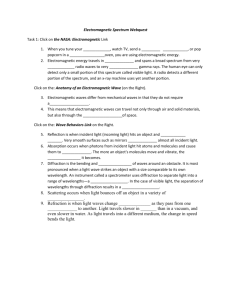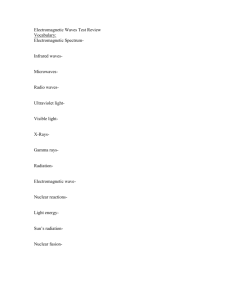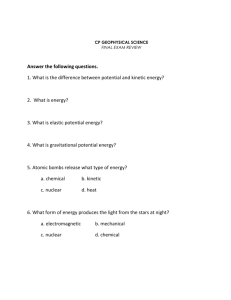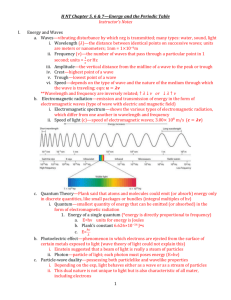Waves - Erina High School
advertisement
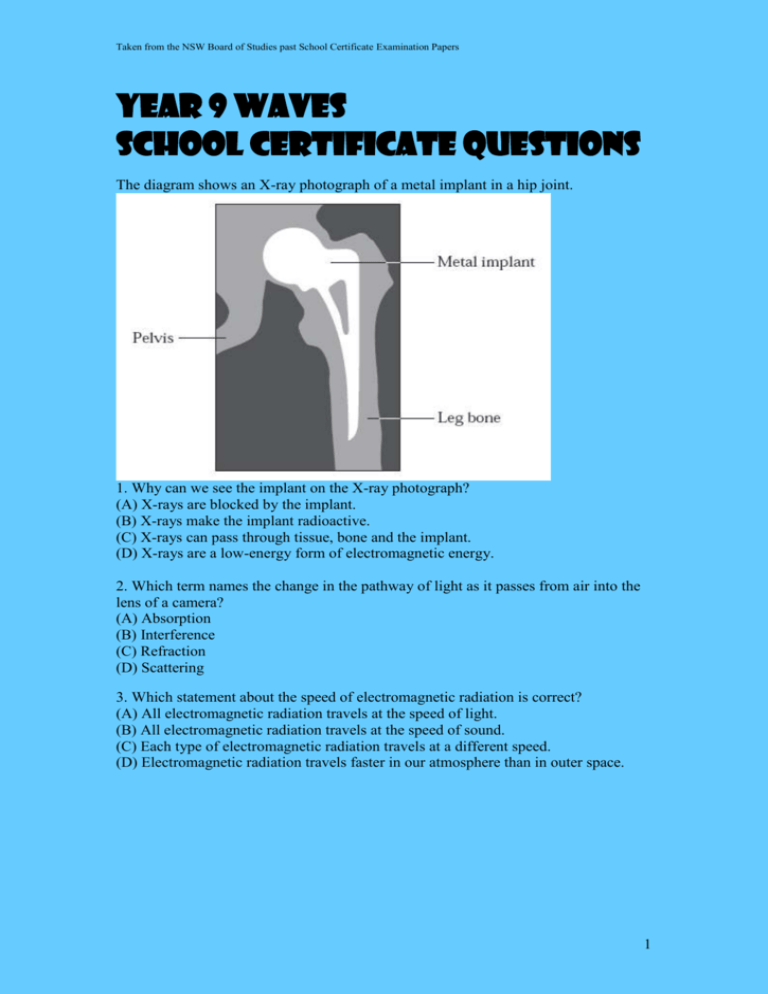
Taken from the NSW Board of Studies past School Certificate Examination Papers Year 9 waves School Certificate Questions The diagram shows an X-ray photograph of a metal implant in a hip joint. 1. Why can we see the implant on the X-ray photograph? (A) X-rays are blocked by the implant. (B) X-rays make the implant radioactive. (C) X-rays can pass through tissue, bone and the implant. (D) X-rays are a low-energy form of electromagnetic energy. 2. Which term names the change in the pathway of light as it passes from air into the lens of a camera? (A) Absorption (B) Interference (C) Refraction (D) Scattering 3. Which statement about the speed of electromagnetic radiation is correct? (A) All electromagnetic radiation travels at the speed of light. (B) All electromagnetic radiation travels at the speed of sound. (C) Each type of electromagnetic radiation travels at a different speed. (D) Electromagnetic radiation travels faster in our atmosphere than in outer space. 1 Taken from the NSW Board of Studies past School Certificate Examination Papers Use Diagrams 1 and 2 to answer Questions 4–7. Diagram 1 represents the electromagnetic spectrum. Diagram 2 illustrates two electromagnetic waves Q and R, both drawn to the same scale. 4. Which type of radiation has the shortest wavelength? (A) Gamma rays (B) Microwave (C) Radio (D) Visible light 5. The distance from crest W to crest X of wave Q is 60 m. What is the distance from crest Y to crest Z on wave R? (A) 20 m (B) 30 m (C) 40 m (D) 50 m 6. What type of wave is Q? (A) Microwave (B) Radio (C) Visible light (D) X-rays 2 Taken from the NSW Board of Studies past School Certificate Examination Papers 7. Which statement is correct for waves Q and R? (A) Q carries more energy than R. (B) Q has more acceleration than R. (C) Q has a greater frequency than R. (D) Q has a longer wavelength than R. Use the following information to answer Questions 8 and 9. An echo-sounder is a device that measures the depth of water. It sends out a sound wave and records how long the wave takes to return to the boat after it rebounds (or ‘echoes’) from the bottom of the body of water. The table shows how to calculate depth in both sea water and fresh water. 8. What conclusion about sound waves can be drawn from the information in the table? (A) They travel more quickly in shallow water than deep water. (B) They travel more quickly in deep water than shallow water. (C) They travel more quickly in fresh water than sea water. (D) They travel more quickly in sea water than fresh water. 9. An echo-sounder is being used on a boat in fresh water. The time for the echo to return is 0.04 seconds. What depth is the water below the boat? (A) 23 m (B) 27 m (C) 29 m (D) 32 m 3 Taken from the NSW Board of Studies past School Certificate Examination Papers Use this information to answer Questions 10–12. An observer can determine the direction of a moving storm by measuring the time interval between seeing the lightning and hearing the thunder. If this time interval is decreasing, then the storm is getting closer to the observer. The diagram shows the location of four people, and the original position of a storm. The table shows the time intervals measured by each person for two successive lightning strikes. 10. Which of the following explains the time difference between the arrival of the lightning and the thunder? (A) Sound travels faster than light. (B) Light travels faster than sound. (C) Sound travels as waves, while light travels in straight lines. (D) Light travels as waves, while sound travels in straight lines. 11. In the table, what is the most likely value for P? (A) 1 (B) 2 (C) 3 (D) 4 4 Taken from the NSW Board of Studies past School Certificate Examination Papers 12. In which direction is the storm most likely to be moving? (A) North-east (B) North-west (C) South-east (D) South-west The diagram shows the wave pattern of a radio wave. 13. Which diagram best represents the wave pattern of the radio wave if the frequency is increased? 14. Use ONE word to complete this sentence: All waves are carriers of ........................................ 15. What feature of a wave is represented by the distance between P and Q in the diagram? 16. What type of electromagnetic radiation is detected as heat? 17. What term is used to describe the number of waves passing a certain point in each second? 5


